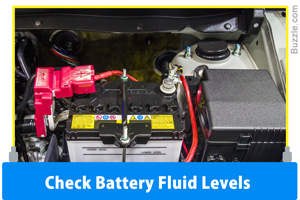
A car battery is an electrochemical device that supplies the much-needed electrical power to your car. Everything that powers the car, including the engine is dependent on the electric battery. The car can create its own power through the use of an alternator which stores the generated electric power in a car storage battery, by charging it. Problems with the car battery can result into problems with ignition and many more devices dependent on the battery for power. So it's important to know how to test a car battery. Regular testing and maintenance enhances its life and improves performance.
Working Of a Car Battery
To test and diagnose a car battery problem, one needs to have a little insight into its working. A battery is an electrolytic cell, designed to store electrical energy in the form of chemical energy and convert the chemical energy back into electrical energy, when required. It is a battery of six individual cells, each supplying about 2.1 V of electricity. So when joined in series and charged, they provide a voltage of 12.6 V approximately. The anode and cathode used in these cells are lead oxide (PbO) and sponge lead (Pb), respectively, and the electrolyte used is dilute sulfuric acid.
There are two processes that occur in a battery: the charging process and discharging process. The charging process converts the electrical energy input into chemical energy. The discharging process converts the chemical energy back into electric current output. When a load is connected across a battery, the circuit of the electrolytic cell is completed. The circuit is completed by flow of charge in form of cations and anions in the cells and in form of electrons through the external circuitry.
The key to maintaining a good battery output is to maintain the chemical balance of the cell. Water is an important factor in the chemical reaction inside the cell. Dropping water levels in a battery can cause the voltage output to drop. If the battery is overcharged, some extra chemical reactions may occur which otherwise, do not. This hampers the reversibility of the chemical reaction. That is, the charging/discharging processes that are reversible reactions cannot occur anymore. Therefore, overcharging the battery should be avoided by monitoring the voltage levels while charging.
There are two processes that occur in a battery: the charging process and discharging process. The charging process converts the electrical energy input into chemical energy. The discharging process converts the chemical energy back into electric current output. When a load is connected across a battery, the circuit of the electrolytic cell is completed. The circuit is completed by flow of charge in form of cations and anions in the cells and in form of electrons through the external circuitry.
The key to maintaining a good battery output is to maintain the chemical balance of the cell. Water is an important factor in the chemical reaction inside the cell. Dropping water levels in a battery can cause the voltage output to drop. If the battery is overcharged, some extra chemical reactions may occur which otherwise, do not. This hampers the reversibility of the chemical reaction. That is, the charging/discharging processes that are reversible reactions cannot occur anymore. Therefore, overcharging the battery should be avoided by monitoring the voltage levels while charging.
Testing Procedure
Let me talk about a precautionary measure, before engaging in a discussion about car battery testing. Make sure that no matter what you do, the two battery terminals are never connected together with each other, as it will lead to a short circuit. The high ampere current that results from it, may simply fry the equipment and even cause fire! So make sure that you avoid making this blunder.
The only way to gauge a battery's performance is to test the voltage output it is offering. The output voltage levels that it provides with and without load can give you an idea of battery health. Here is a step wise procedure explaining car battery testing.

Step 1
Handling car batteries can be hazardous, with sulfuric acid being the operating chemical inside them. Ergo it's essential that you wear protective gloves, clothing and safety goggles. That way, you are well protected from any electrical hazards that might possibly occur.

Step 2
So to test a battery, arm yourself with a voltmeter and set the dials on the 0-50 V range. Disconnect the battery from the car connections by following the details in the car manual to the word. While doing so attach a 9V alkaline battery to the car PCM as otherwise it loses its programmed settings.

Step 3
Set voltmeter to DC. Connect positive red lead of voltmeter to positive of battery terminal and the black lead to the negative terminal. Check the voltage level. If it's in the range of 12.6 to 12.8, your battery is doing well and adequately charged. Anything below that, like 10V or lower means that the battery is in need of charging, and you might want to check the alternator.

Step 4
Now reconnect the battery and start the car. Keep it in idling mode and check the voltage reading between same points again. If it is around 10V, then the battery is okay. Anything below 10V means that either the battery needs charging, or some other problems are causing the voltage decline.

Step 5
Next thing to check is the fluid levels in your battery. To do this you must disconnect the battery again of course. Open up the battery cover and peep into the compartments of cells inside. The electrode plates should be submerged in the electrolytic fluid. If they are not, you must add distilled water to the cell compartment only uptil the fluid level rises about a one-fourth of an inch above the plates.
Another reason which may cause the battery to have a lot output, is a car alternator problem. Get it checked with the mechanic as soon as possible. You might alternatively use a battery tester, which has its own internal load resistance, that makes checking batteries simpler. Thus, you can test your car battery with ease, armed with just an humble voltmeter and a discerning mind. When you manage to deal with your car problems, on your own, it's indeed a satisfying experience.
Hiç yorum yok:
Yorum Gönder
Yapacağınız yorumlar bizim için değerlidir. (Lütfen yorum bırakın)